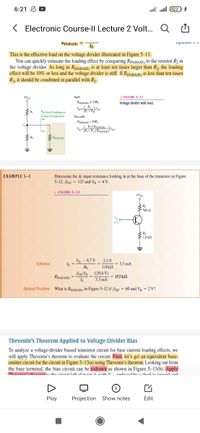
Introductory Circuit Analysis (13th Edition)
13th Edition
ISBN: 9780133923605
Author: Robert L. Boylestad
Publisher: PEARSON
expand_more
expand_more
format_list_bulleted
Question
Solve the related problem.

Transcribed Image Text:6:21 A D
lll all 23
< Electronic Course-ll Lecture 2 Volt. Q
KIN(BASE)
EquaIUn -
IE
This is the effective load on the voltage divider illustrated in Figure 5–11.
You can quickly estimate the loading effect by comparing RiN(BASE) to the resistor R2 in
the voltage divider. As long as RiNBAsE) is at least ten times larger than R2, the loading
effect will be 10% or less and the voltage divider is stiff. If RIN(BASE) is less than ten times
R2, it should be combined in parallel with R2.
Stif:
ResmAS, 1OR;
+Vc
FIGURE 5-11
Voltage divider with load.
ReenASE looking in
at base of transistor
Not stiff:
RINBASE) < 1OR,
R: || RINBASE)
RINBASE
EXAMPLE 5-3
Determine the de input resistance looking in at the base of the transistor in Figure
5-12. Bpc = 125 and Vg = 4 V.
FIGURE 5-12
+Ver
Rc
4 V
SRE
$ 1.0 k
VB - 0.7 V 3.3 V
Solution
3.3 mA
RE
1.0 kn
BocVB 125(4 V)
RIN(BASE) =
3.3 mA
152 kN
Related Problem What is RINBASE) in Figure 5-12 if Bpc = 60 and Vg = 2 V?
Thevenin's Theorem Applied to Voltage-Divider Bias
To analyze a voltage-divider biased transistor circuit for base current loading effects, we
will apply Thevenin's theorem to evaluate the circuit. First, let's get an equivalent base-
emitter circuit for the circuit in Figure 5–13(a) using Thevenin's theorem. Looking out from
the base terminal, the bias circuit can be redrawn as shown in Figure 5–13(b). Apply
Thauanin'e thanam tn tha ninnit laft of nnint A uith V ranlanad hu a chat ta neund and
Play
Projection Show notes
Edit
Expert Solution
This question has been solved!
Explore an expertly crafted, step-by-step solution for a thorough understanding of key concepts.
This is a popular solution
Trending nowThis is a popular solution!
Step by stepSolved in 3 steps with 1 images

Knowledge Booster
Learn more about
Need a deep-dive on the concept behind this application? Look no further. Learn more about this topic, electrical-engineering and related others by exploring similar questions and additional content below.Similar questions
Recommended textbooks for you
 Introductory Circuit Analysis (13th Edition)Electrical EngineeringISBN:9780133923605Author:Robert L. BoylestadPublisher:PEARSON
Introductory Circuit Analysis (13th Edition)Electrical EngineeringISBN:9780133923605Author:Robert L. BoylestadPublisher:PEARSON Delmar's Standard Textbook Of ElectricityElectrical EngineeringISBN:9781337900348Author:Stephen L. HermanPublisher:Cengage Learning
Delmar's Standard Textbook Of ElectricityElectrical EngineeringISBN:9781337900348Author:Stephen L. HermanPublisher:Cengage Learning Programmable Logic ControllersElectrical EngineeringISBN:9780073373843Author:Frank D. PetruzellaPublisher:McGraw-Hill Education
Programmable Logic ControllersElectrical EngineeringISBN:9780073373843Author:Frank D. PetruzellaPublisher:McGraw-Hill Education Fundamentals of Electric CircuitsElectrical EngineeringISBN:9780078028229Author:Charles K Alexander, Matthew SadikuPublisher:McGraw-Hill Education
Fundamentals of Electric CircuitsElectrical EngineeringISBN:9780078028229Author:Charles K Alexander, Matthew SadikuPublisher:McGraw-Hill Education Electric Circuits. (11th Edition)Electrical EngineeringISBN:9780134746968Author:James W. Nilsson, Susan RiedelPublisher:PEARSON
Electric Circuits. (11th Edition)Electrical EngineeringISBN:9780134746968Author:James W. Nilsson, Susan RiedelPublisher:PEARSON Engineering ElectromagneticsElectrical EngineeringISBN:9780078028151Author:Hayt, William H. (william Hart), Jr, BUCK, John A.Publisher:Mcgraw-hill Education,
Engineering ElectromagneticsElectrical EngineeringISBN:9780078028151Author:Hayt, William H. (william Hart), Jr, BUCK, John A.Publisher:Mcgraw-hill Education,

Introductory Circuit Analysis (13th Edition)
Electrical Engineering
ISBN:9780133923605
Author:Robert L. Boylestad
Publisher:PEARSON

Delmar's Standard Textbook Of Electricity
Electrical Engineering
ISBN:9781337900348
Author:Stephen L. Herman
Publisher:Cengage Learning

Programmable Logic Controllers
Electrical Engineering
ISBN:9780073373843
Author:Frank D. Petruzella
Publisher:McGraw-Hill Education

Fundamentals of Electric Circuits
Electrical Engineering
ISBN:9780078028229
Author:Charles K Alexander, Matthew Sadiku
Publisher:McGraw-Hill Education

Electric Circuits. (11th Edition)
Electrical Engineering
ISBN:9780134746968
Author:James W. Nilsson, Susan Riedel
Publisher:PEARSON

Engineering Electromagnetics
Electrical Engineering
ISBN:9780078028151
Author:Hayt, William H. (william Hart), Jr, BUCK, John A.
Publisher:Mcgraw-hill Education,